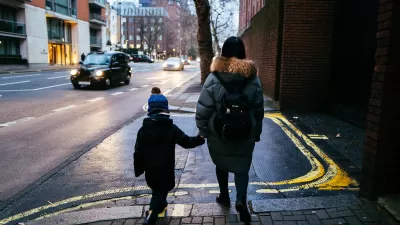During the nightly blackouts designed to protect London from aerial attack during World War II, authorities used white paint as a cheap tool for making the city navigable in the darkness. Could London offer lessons for building resilient cities?
With streets, buildings, and vehicles substantially darkened to hide London from Nazi bombers, authorities had to devise a solution for making the city navigable at night. "A meticulous and detailed re-painting of everyday objects and landmarks was thus launched," recounts Geoff Manaugh, "with everything from curbs to clothing getting rhythmic white bands and stripes added to them for easier detection."
"That this surreal and temporary redesign of the city was motivated by war—or, more specifically, by the terror of avoiding Nazi obliteration from above—should not take away from the possible urban lessons such a remaking of the city might offer us today," he continues. "These are simple design alterations that make the city resilient, safe, and navigable during power cuts, and, in many cases, require nothing more than a patterned coat of paint and some specially designed outerwear."
FULL STORY: How London Was Redesigned To Survive Wartime Blackouts

Planetizen Federal Action Tracker
A weekly monitor of how Trump’s orders and actions are impacting planners and planning in America.

Restaurant Patios Were a Pandemic Win — Why Were They so Hard to Keep?
Social distancing requirements and changes in travel patterns prompted cities to pilot new uses for street and sidewalk space. Then it got complicated.

Map: Where Senate Republicans Want to Sell Your Public Lands
For public land advocates, the Senate Republicans’ proposal to sell millions of acres of public land in the West is “the biggest fight of their careers.”

Maui's Vacation Rental Debate Turns Ugly
Verbal attacks, misinformation campaigns and fistfights plague a high-stakes debate to convert thousands of vacation rentals into long-term housing.

San Francisco Suspends Traffic Calming Amidst Record Deaths
Citing “a challenging fiscal landscape,” the city will cease the program on the heels of 42 traffic deaths, including 24 pedestrians.

California Homeless Arrests, Citations Spike After Ruling
An investigation reveals that anti-homeless actions increased up to 500% after Grants Pass v. Johnson — even in cities claiming no policy change.
Urban Design for Planners 1: Software Tools
This six-course series explores essential urban design concepts using open source software and equips planners with the tools they need to participate fully in the urban design process.
Planning for Universal Design
Learn the tools for implementing Universal Design in planning regulations.
Heyer Gruel & Associates PA
JM Goldson LLC
Custer County Colorado
City of Camden Redevelopment Agency
City of Astoria
Transportation Research & Education Center (TREC) at Portland State University
Camden Redevelopment Agency
City of Claremont
Municipality of Princeton (NJ)





























